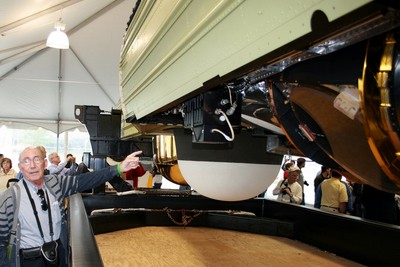The Bird is the wordby Dwayne Day
|
| The fact that Pressel can talk about HEXAGON is still a surprise to many of the people who worked on the reconnaissance satellite. |
Phil will be speaking in front of the last remaining HEXAGON at the National Museum of the United States Air Force throughout the day on Tuesday, June 14. The museum just opened its new building, housing numerous aircraft brought over from the hangars located on Wright Patterson Air Force Base, including the presidential planes and the research and development planes such as the XB-70 Valkyrie. But a big part of the building is devoted to space artifacts including a Titan IV rocket and the HEXAGON, which was previously located in an adjacent building and is now tucked alongside the Valkyrie’s left wing.
There were over a thousand people who worked on HEXAGON, and although Pressel has been talking about the satellite, he stresses that it was a major group effort, one that took place in the utmost secrecy. The fact that Pressel can talk about HEXAGON is still a surprise to many of the people who worked on the reconnaissance satellite. The CIA started studies of a new reconnaissance search satellite in 1963, seeking a system that could photograph vast amounts of territory at relatively high resolution—less than a meter initially, but significantly better as the program continued. The satellite’s purpose was to find new construction and evidence of new weapons systems inside the vast Soviet landmass. Perkin-Elmer of Danbury, Connecticut, secured the contract to build the camera system, with Lockheed building the spacecraft that supported it. The first one was launched in 1971, the last in 1986, with 19 successes out of 20 built. But the program was not officially declassified until 2011.
Pressel started working on the HEXAGON in the mid-1960s at Perkin-Elmer and has written a book about the program, Meeting the Challenge. He was always proud of his work on the project. He and his family were Jews living in Belgium when the Nazis invaded and they fled into France and went into hiding, surviving the war and eventually immigrating to the United States where he became an engineer. Pressel did not want to build weapons, and was glad that he worked on a system that he believes helped to keep the peace by providing valuable intelligence on the Soviet Union.
| Pressel remembers another proposal that he was personally involved in when he was called to Perkin-Elmer to work with two other people, one of them a NASA astronaut. They were assigned to evaluate the possibility of sending the HEXAGON camera system to Mars. |
The vehicle on display was not a flight-ready HEXAGON. It was the fully operational engineering mockup of the camera system, which was continuously modified as the flight vehicles were upgraded until the mid-1980s, when HEXAGON was finally cancelled. The camera was fully functional, and is equipped with film supply reels and takeup spools, some located inside reentry vehicles. A used reentry vehicle is located nearby. The rear part of the vehicle, which contained the spacecraft’s fuel and power supplies, is a non-functioning mockup.
There were proposals to fly the camera hardware that is now in the museum. After the last HEXAGON was destroyed when its Titan 34D rocket blew up over its launch pad in 1986, officials at Perkin-Elmer proposed to the National Reconnaissance Office that the engineering mockup be mounted on a pallet and carried into orbit in the Space Shuttle’s payload bay. But the shuttle could not fly into polar orbit, limiting what the HEXAGON could photograph, and the proposal was not accepted. Pressel remembers another proposal that he was personally involved in when he was called to Perkin-Elmer to work with two other people, one of them a NASA astronaut. They were assigned to evaluate the possibility of sending the HEXAGON camera system to Mars. Although Pressel does not remember the details, and the film-based HEXAGON would have been an odd choice for a Mars mission, he does remember that it was a highly-classified small study that he and the other two men conducted inside a secure facility. If their study report still exists, it has not been declassified.
If you happen to get to the museum on June 14, head over to the HEXAGON where Phil will be talking in front of his big camera. I’ll be the guy nearby holding a much smaller camera.
